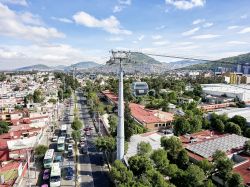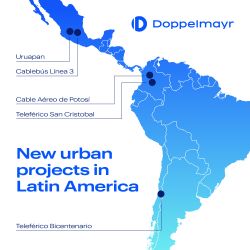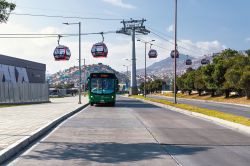Doppelmayr ropeways on track for success in Latin AmericaIn Latin America, the benefits of ropeways have long been highly acclaimed as a means of public transport in the urban environment. Doppelmayr has already implemented many ropeway projects in the region, including the world’s biggest urban ropeway network linking the Bolivian cities of La Paz and El Alto. The market leader is now continuing its success record with another five new installations in Bogotá, Mexico City, Uruapan and Santiago de Chile. Latin America is the trailblazer where urban ropeways are concerned. These systems open up an entirely new, independent level for sustainable public transit, overcome any obstacle, however complex, and significantly speed up daily transport links for city dwellers. The installations built to date have enjoyed a huge success and inspired more projects in the future. 30-minute time saving: Cable Aéreo de Potosí In Colombia’s capital, Bogotá, Doppelmayr ropeways numbers two and three are currently under construction. The 3.3-kilometer-long 10-passenger gondola Cable Aéreo de Potosí is scheduled to open in 2027. Around 600,000 residents are set to benefit from the comfortable, straightforward and climate-friendly connection that will enable its passengers to do the trip from the district of Potosí in the southwest of Bogotá to the TransMilenio bus rapid transit system station in just ten minutes. Bogotá’s former mayor, Claudia López Hernández, said: “The new ropeway will enable our citizens to save 30 minutes on their daily journeys. In addition, we shall be adding new social amenities to the four stations. These include schools, nurseries, care facilities and centers for health, culture and sport. As a consequence, this project will help to boost quality of life for the people in our city.” Link to transport hub: Teleférico San Cristobal San Cristóbal, Bogotá’s fourth locality in the southeast of the city, can also look forward to a safe, fast and reliable connection to the transport hub Portal 20 de Julio in the form of a Doppelmayr ropeway, providing access to the TransMilenio bus rapid transit system. From 2026, this 10-passenger gondola will enhance quality of life for the district’s 400,000 inhabitants. This and the Cable Aéreo de Potosí ropeway project are expected to see a level of success and extremely positive social impact comparable to the TransMiCable gondola that opened in Ciudad Bolívar in 2018. Since then, the residents of that district, who had previously suffered from poor transport links, have been able to reap considerable benefits from the reliable, fast and convenient connection. This means of transport, which is fully integrated into the public transport network, is now used by up to 25,000 people on a daily basis. Positive social and economic change: Cablebús Línea 3 Mexico is also equipping itself with urban ropeway projects to address the future mobility needs of its cities. The Cablebús Línea 3 marks the third ropeway line currently under construction in Mexico City. It will link Los Pinos/Constituyentes and Vasco de Quiroga over a length of 5.5 kilometers. The line encompasses six stations and is designed to carry 12 million passengers a year in its final stage. Doppelmayr Mexico CEO Konstantinos Panagiotou reports from experience that the high capacity of the ropeway improves access to jobs, schools and education facilities. That makes the Cablebús Línea 3 another important building block toward connecting urban infrastructure, increasing the attractiveness in city’s districts, and transforming the public transport system in the direction of greater sustainability. Mexico City as role model: Uruapan The Mexican state of Michoacán is investing three billion pesos (roughly 155 million euros) in the construction of an urban ropeway – including buildings and associated structures – in the city of Uruapan. The ropeway connection will cover a length of 8 kilometers and will carry up to 1,500 passengers an hour in each direction. “Projects like this one have a positive social impact as they not only provide a fast, safe and barrier-free means of transport for the population but also act as an economic driver in the area around the ropeway stations,” says Konstantinos Panagiotou. “With the development of this ropeway, a major step is made toward transforming local transit in the direction of greater sustainability in Uruapan.” Paving the way for urban ropeway mobility in Chile: Teleférico Bicentenario Last but not least, Santiago de Chile also recently gave the go-ahead for Doppelmayr to build an urban ropeway. The 3.4-kilometer route will connect three municipalities from Huechuraba on the northern perimeter of the metropolitan area to Providencia in the north of Santiago City and is due to go into service in 2026. Photos © Doppelmayr Seilbahnen GmbH |
ropeways.net | Home | Urban | 2024-03-07
More articles:
Utah’s ski industry contributed $1.94 billion in nonresident visitor spending
2024-05-10
Vail Resorts Named by Newsweek as One of the Most Trustworthy Companies in America
2024-05-09
Sunkid: A colorful surface lift project by Star Lifts USA Inc.
2024-05-08
Google Adsense








 Back
Back Add Photos
Add Photos Print
Print